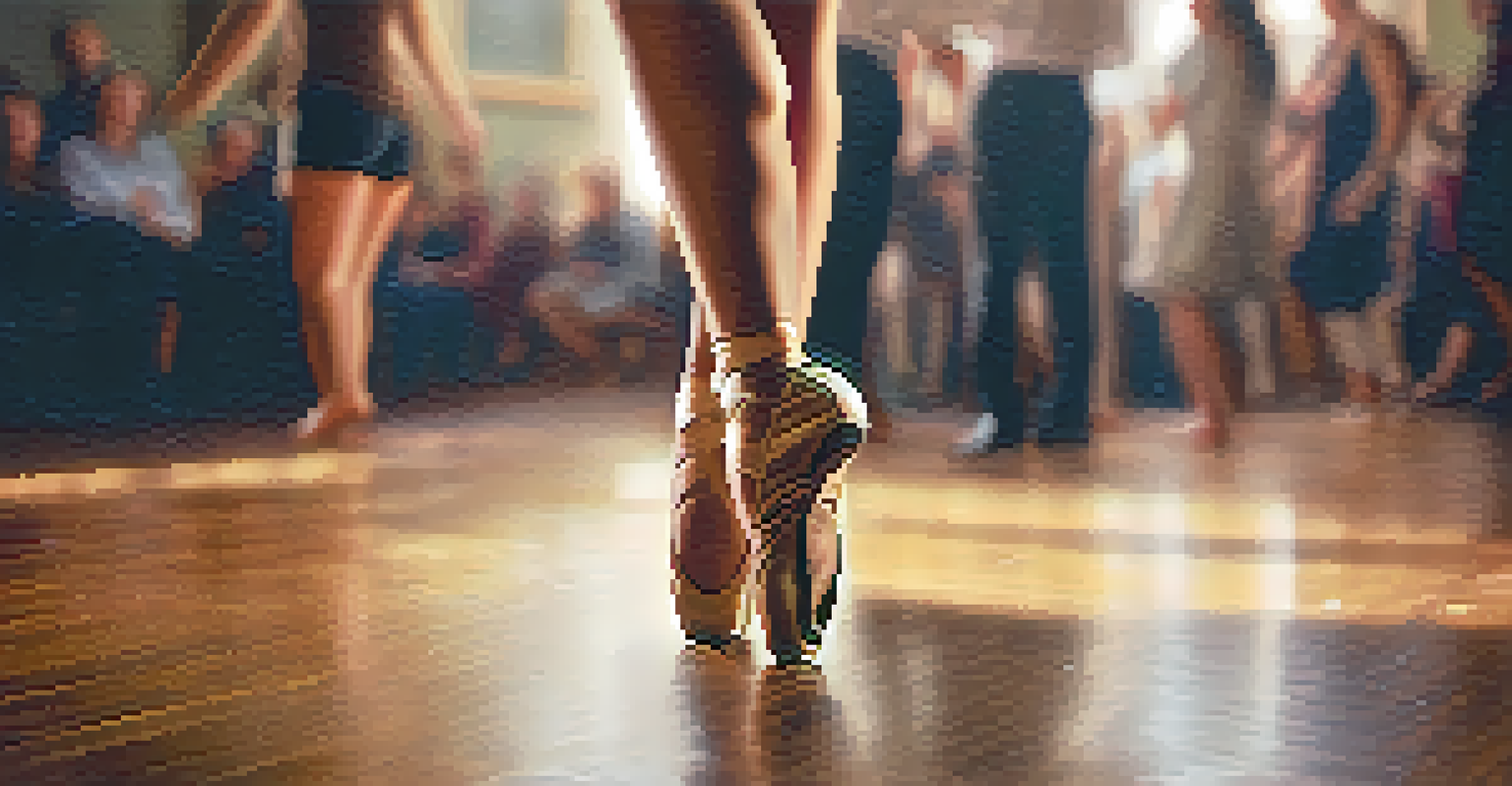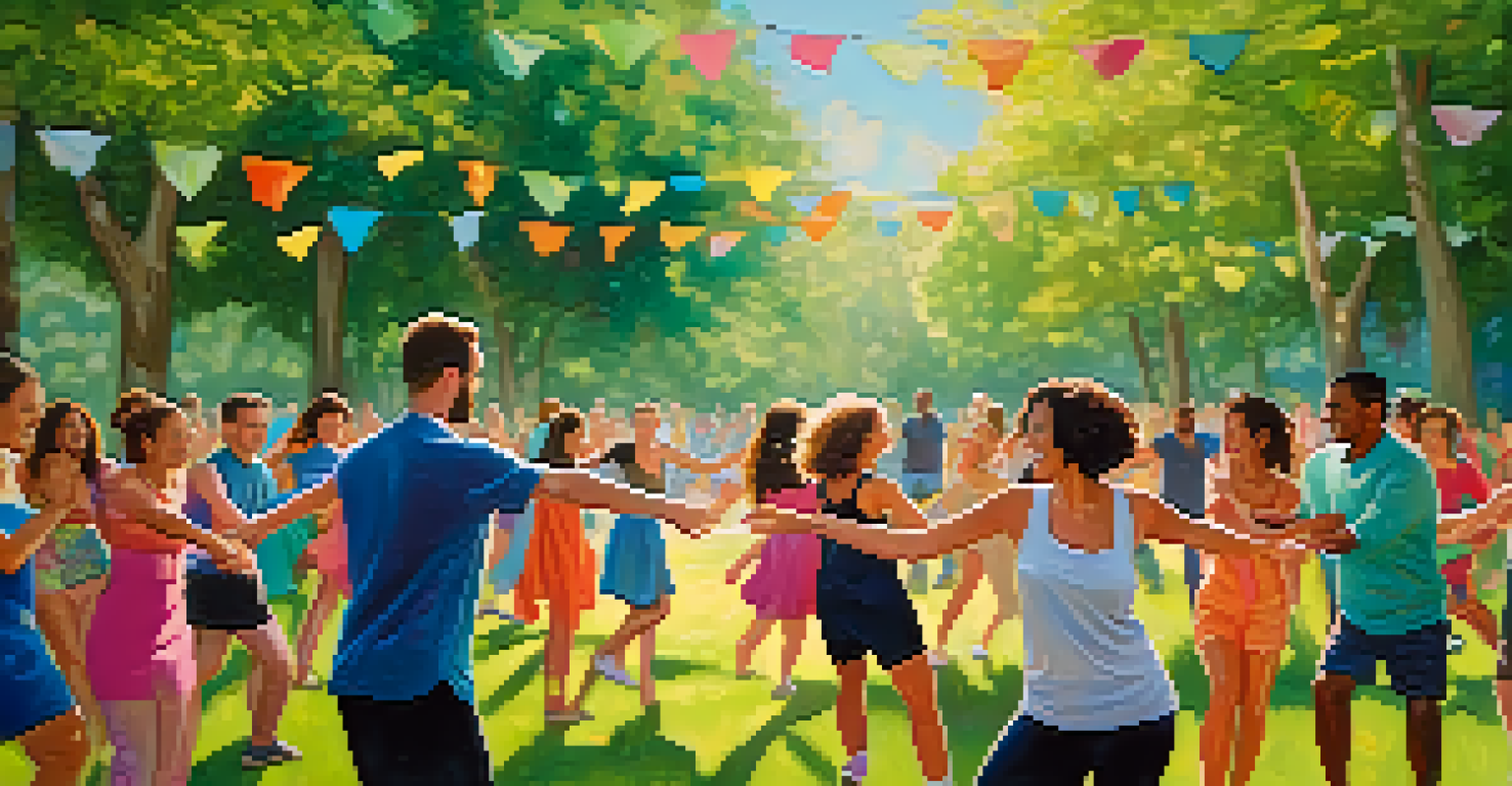The Role of Music in Dance Therapy: Healing Through Movement

Understanding Dance Therapy: A Brief Overview
Dance therapy, or dance/movement therapy (DMT), is a creative art form that uses movement to support emotional, cognitive, and physical integration. It's a therapeutic practice that taps into the body's innate ability to express feelings and experiences through movement. By integrating music, dance therapy helps individuals communicate emotions that might be difficult to articulate verbally.
Dance is the hidden language of the soul.
The foundation of dance therapy lies in the belief that movement can facilitate healing. Participants engage in structured or spontaneous dance movements guided by trained therapists, fostering a safe space for self-expression. This approach is particularly beneficial for individuals facing trauma, stress, or anxiety, as it encourages them to reconnect with their bodies and emotions.
In essence, dance therapy is more than just dancing; it's a holistic approach to mental health that combines the physicality of movement with the emotional resonance of music. This unique blend allows individuals to explore their feelings in a supportive environment, paving the way for profound personal transformation.
The Symbiotic Relationship Between Music and Movement
Music serves as the backbone of dance therapy, creating a rhythm and atmosphere that enhances the movement experience. The melodies can evoke various emotions, guiding the dancer's movements and deepening their emotional expression. Whether it's a fast-paced song that invites energetic movement or a slow, soothing melody that encourages introspection, music shapes the entire therapeutic journey.

Moreover, music influences how clients connect with their bodies and surroundings. The beat can help individuals synchronize their movements, promoting a sense of unity and flow. This connection between music and movement allows participants to express themselves more freely, often leading to breakthroughs in their emotional and psychological well-being.
Dance Therapy Uses Movement for Healing
Dance therapy facilitates emotional and physical healing by allowing individuals to express feelings through movement and music.
In dance therapy, the relationship between music and movement is not just about entertainment; it's a therapeutic alliance that fosters healing. By tapping into the emotional power of music, therapists can help clients navigate their feelings, making the process of healing more profound and impactful.
How Music Enhances Emotional Expression in Therapy
One of the most significant benefits of incorporating music into dance therapy is its ability to facilitate emotional expression. Many individuals struggle to articulate their feelings verbally, but music can act as a bridge, allowing them to explore and express emotions through movement. This process can be particularly liberating for those who feel stuck or overwhelmed.
Music can change the world because it can change people.
For instance, a participant may feel anger or sadness that they've been unable to express. Hearing a powerful song can evoke those emotions, prompting them to move in ways that reflect their inner experiences. This cathartic release can lead to greater self-awareness and understanding, ultimately paving the way for healing.
Additionally, the emotional connection to music can create a safe space for vulnerability. When participants feel supported by the music and the therapeutic environment, they may be more willing to delve into their emotions, fostering a deeper therapeutic experience that encourages healing and growth.
The Role of Improvisation in Dance Therapy Sessions
Improvisation is a key component of dance therapy, allowing participants to create movements spontaneously in response to music. This unstructured approach empowers individuals to explore their emotions in real-time, offering a unique opportunity for self-discovery. Improvisation invites creativity and authenticity, encouraging clients to let go of preconceived notions about movement and simply express themselves.
Through improvisational dance, participants learn to listen to their bodies and the music, fostering a heightened sense of awareness. This practice can lead to unexpected revelations about their emotional states and personal experiences. For example, an individual may discover a movement that embodies their feelings of joy or sadness, providing insight into their emotional landscape.
Music Deepens Emotional Expression
Incorporating music into dance therapy enhances emotional expression, helping participants articulate feelings that may be hard to verbalize.
By embracing improvisation, dance therapy creates a dynamic and fluid environment where healing can occur naturally. This approach not only nurtures creativity but also builds confidence, as participants realize that their unique movements are valued and respected.
Music's Influence on Group Dynamics in Therapy
In group dance therapy sessions, music plays a crucial role in shaping the dynamics among participants. When individuals move together in response to music, they create a collective experience that fosters connection and community. This shared experience can break down barriers, helping participants feel less isolated in their struggles.
The communal aspect of music encourages empathy and understanding, as participants witness each other’s expressions and emotions. This shared journey can lead to powerful moments of bonding, as individuals support each other through their unique healing processes. For many, the group dynamic enhances the therapeutic experience, making it feel more meaningful and impactful.
Furthermore, music can help establish a rhythm within the group, guiding movements and interactions. Whether it's through synchronized dancing or shared improvisation, the music acts as a facilitator, promoting collaboration and mutual support among participants.
Cultural Significance of Music in Dance Therapy
Music is deeply rooted in culture, and its significance in dance therapy cannot be understated. Different musical styles can resonate with various individuals based on their cultural backgrounds, providing a sense of familiarity and comfort. This connection to cultural music can enhance the therapeutic experience, allowing participants to engage more fully in the process.
Incorporating culturally relevant music into dance therapy sessions can help individuals feel seen and understood. It acknowledges their unique backgrounds and experiences, fostering a sense of belonging within the therapeutic space. This cultural sensitivity not only enriches the therapy but also validates the participants' identities.
Cultural Music Enriches Therapy Sessions
Integrating culturally relevant music in dance therapy fosters a sense of belonging and validates participants' identities in the healing process.
Moreover, exploring diverse musical traditions in dance therapy can promote a broader understanding of emotions and healing practices. By embracing the cultural significance of music, therapists can create more inclusive and effective therapeutic environments that honor the richness of each participant's heritage.
The Future of Dance Therapy and Music Integration
As the fields of music and dance therapy continue to evolve, the integration of technology and innovative practices is on the rise. Virtual reality, for example, is beginning to play a role in creating immersive environments where participants can engage with music and movement in new ways. This technological advancement offers exciting possibilities for enhancing the therapeutic experience.
Additionally, research is increasingly highlighting the benefits of combining music with dance therapy. As more studies emerge, they provide valuable insights into how music influences emotional healing and movement expression. This growing body of evidence may lead to more widespread acceptance and recognition of dance therapy as a legitimate form of treatment.

Looking ahead, the future of dance therapy promises to be dynamic and transformative. By continually exploring new ways to integrate music and movement, therapists can enhance their practice and offer even more powerful healing experiences for their clients.